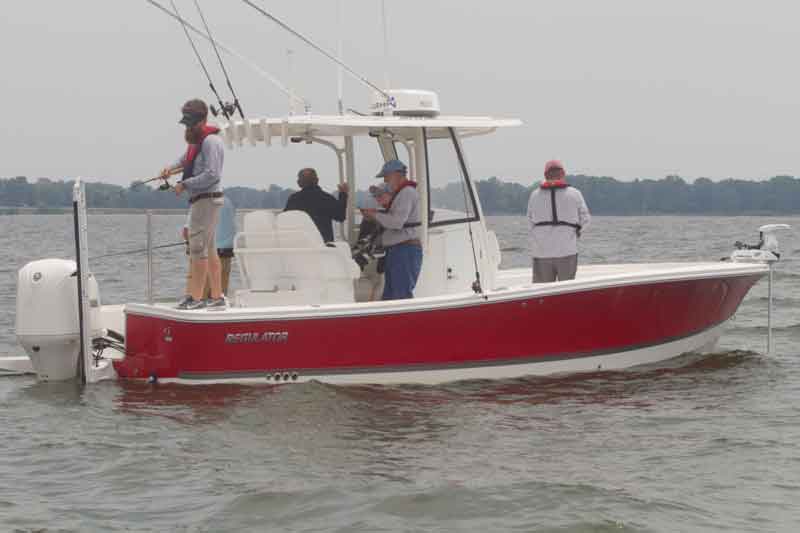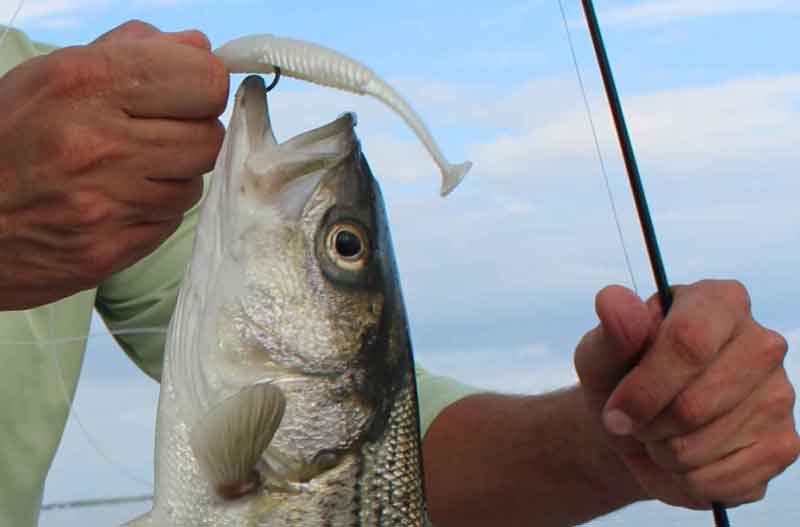Some 20 to 30 years ago advances in gear and lures changed the way many of us see Chesapeake Bay fishing. Anglers up and down the shores of the Bay set aside the pool-cue rods, wire lines, and 20-ounce weights, in favor of sensitive fast-action graphite rods spooled up with braid line. At other times of the year we ceased buying piles of peeler crab and bunker and instead invested the bait budget into soft plastic lures often maligned as “those gummy-bear things” by traditionalists. Light-tackle jigging slowly became the norm, as opposed to an eccentricity. Sure, many of us maintain a wide selection of gear and keep all our options open for numerous other types of tactics. But on the whole, light tackle jigging — or “the LTJ,” as it’s known — has evolved from an oddity into one of the most popular forms of fishing around.

And we say Halleluiah! LTJ fishing is incredibly fun, highly effective, flexible in its applications, and as an added bonus for striper fans it also appears to have a lower catch-and-release mortality rate than many other forms of fishing for that species. But, what constitutes LTJ in the first place? For the purpose of this conversation, let’s limit the field to spinning or conventional gear of the 25-pound-class and under rigged with leadheads and plastic body jigs. Yes, LTJ means different things to different people, and can include a much wider range of gear and tactics. We’d agree without hesitation that jigging spoons, for example, are a valid tool of light tackle jiggers. But different tools require different tactics and mind-sets. We want to dig deep into the details, here, and in order to do so we’re going to limit the discussion to the leadhead and plastic parameters.
Setting all the other options aside, as you reach for those jigs just how effective you’ll be at using them has a direct relationship with your ability to pick out the right lure for the situation. How will you know what to reach for? Take these three critical factors into account.
Jig Weight
Choosing the right jig weight comes down to reaching the proper depth while accounting for the factors that will affect how easily you can or can not maintain that depth, including current (both at the surface and at depth), and wind and drift speed. On course, these factors are constantly changing—one second that half-ounce jighead might be perfect, but after that breeze kicked up it could prove insufficient. That said, as a general rule of thumb with outside influences excluded from the equation, when fishing standard-issue four to six-inch soft plastics good starting points for different depth ranges include:
- A quarter-ounce for casting at shorelines or to shallows of three to five feet of water.
- A half-ounce for casting shorelines with decent drops down to eight to 12 feet of water.
- Three-quarters of an ounce for retrieving in eight to 10 feet down to 12 or 15 feet of water, or vertical jigging in water to 20 or 25 feet.
- An ounce or more for retrieving or vertical jigging in 20 feet or more of water.
Remember, this is excluding the need for additional weight due to external factors. If you’re trying to bounce your jig along bottom as you retrieve in 30 feet of water with a roaring current as you drift along in a 15-knot breeze, you may well need to double the weight of that one-ounce jighead in order to maintain contact with the bottom.
It’s also important to note that these factors can be combated to some degree by altering tactics; instead of casting down-current cast up-current, and you can reach deeper with the same amount of weight. Or if you’re vertical jigging with a fast drift, cast downwind a bit and you can hit bottom and then keep the jig more or less vertical for longer before your line gets stretched out.
Another way to boost your catch rate in scenarios like these is to utilize a position-holding feature like Minn Kota’s Spot-Lock. If you have a trolling motor on the bow and you can merely press a button and have the motor and GPS hold you in place, virtually all the outside effects of wind and drift can be mitigated. At the same time, the effect of the current will be stabilized and a lot of the guesswork gets eliminated from the equation. Added Bonus: when you’re Spot-Locked in place and have ID’ed the correct weight jig, you can work the exact same structure or hotspot over and over again without having to drift and then re-set the boat.
Jig Size, Shape, and Action
Should you be tossing a four-inch plastic with a twister tail, a six-inch shad body, or a nine-inch eel? The answer, of course, is yes. No. Maybe. Again, you’ll have to take a number of variables into account, but we can boil most of the discussion down to two imperatives: matching the hatch, and providing good action.
Matching the hatch is relatively simple to understand. There will be times and places where predators are feeding almost exclusively on long, skinny baitfish, and only long, skinny offerings will get hit. Conversely, when baits with deeper, rounded bodies are what the fish are focused on, plastics that match them may be a must-have. Similarly, the baitfish’s size may also need to be matched.
Lure size may also matter, however, depending on the size and feeding habits of a particular target species. A 40-inch striper is much more likely to chase after a very large bait during cold months of the year, for example, simply because it doesn’t want to expend a lot of energy chasing down a tiny morsel—he often wants a big meal, regardless of the prevailing bait.
Unlike size and shape, the plastic’s action usually comes into play more or less depending on an angler’s skill level. Some straight-tail plastics depend on good angler input to create a fish-attracting wiggle, while some paddle tails or twisters require little more than a neophyte with enough skill to crank the reel. The bottom line? When a total newb angler steps aboard your boat it’s a good idea to set them up with a very pliable paddle tail that “swims” no matter what. Otherwise, leave the decision to an angler’s personal preference. One exception: vertical jigging. In that case, straight tail jigs almost always beat out paddlers (which often spin on the sink), and if you have inexperienced folks aboard, you’ll probably be better off if you set them up with straight tails and spend a bit more time coaching them.

Lure Color
Choosing the best color is, of course, always a critical—and difficult—call to make. However, these three colors are on most sharpie’s go-to list:
- White
- Chartreuse
- Pink
While recognizing that different skilled and successful anglers may have different feelings on this, most people are likely to at least include two of these colors in their own list of favorites. And most are also likely to carry 10 or more other colors as well as different variations and/or combinations of these, because you simply don’t know what’s going to work best on any given day, for any given species, in any given place.
That said, as a general guideline always remember to try to match your lure color to the water color. In clear water, white often works best; in green water chartreuse commonly tops the list; in muddy waters root-beer can be surprisingly effective; and when you’re night fishing and the water looks black, black will often prove productive. So use your top picks as a starting point, but be quick to change out colors and lean towards those that match the conditions until you find what works.
Skirted Jigs
To skirt, or not to skirt? That is the question, at least it is for many anglers jigging soft plastics on leadheads for stripers in the Chesapeake. There’s no doubt that at times skirting a lure gives it a serious effectiveness boost. Skirts can add color contrast, slow the sink, and add some action to a soft plastic jig. Dittos goes for using a bucktail/plastic combo, although in this case changing colors will be a bit tougher (requiring you to cut and re-tie). It makes one wonder, just to be on the safe side shouldn’t you skirt all your jigs at all times?
Nope—as with many things in fishing, it isn’t that simple. There will be times when an un-skirted jig unquestionably out-fishes the skirted offerings. Be it a matter of visual presentation, faster sink rates, or action, some fraction of the time bare plastics do prove better. Exactly when and where this will happen is tough to say. Quick-retrieve situations in warm, shallow water seem to be one scenario where skirt-less jigs often over-perform. High-current scenarios when you need as rapid a sink as possible is another where tossing a bare jig sometimes seems like a better bet. But there are certainly no hard and fast rules. So which should you use and when?
Experimentation is the key, as is often the case when fishing. If you’re fishing alone and feel like you’re not getting as many hits as you should be considering the situation, try swapping it up. Go-to starter jigs should include perennial favorites like a white plastic with a chartreuse skirt, the reverse pattern, or a pink over white, and if you’re not catching start rapidly rotating through different skirted and skirt-less options. When you have multiple anglers aboard it’s much easier to quickly ascertain what’s most effective at any given time, since you can try multiple options all at once. Make sure everyone starts with different color combinations, some lures skirted and some without. As the various anglers aboard have varying levels of success, start changing lures that aren’t getting smacked to match the ones that are.
Put all of the above factors together, and they’ll usually lead you to make a good choice, or choices, until you start catching fish. So take weight, size, shape, and action, and color into account each and every time you reach for those gummy-bear things — and enjoy catching the heck out of those fish on the LTJ.
See these other jigging articles to learn more:
Gearing Up Part III: Choosing Ideal Jigging Gear